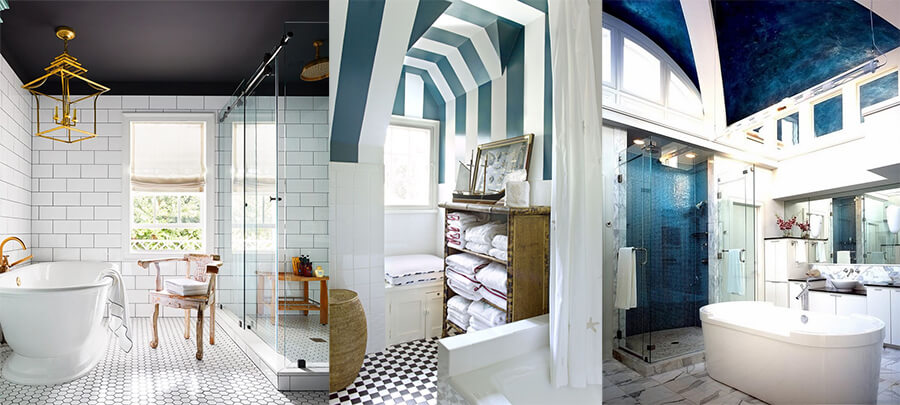Have you ever stepped into your bathroom, looked up, and thought that it was high time for a change? Perhaps you’ve noticed the wear and tear that’s been sneaking up on your bathroom ceiling. You might have even contemplated calling in the professionals, but let’s take a pause and consider an exciting alternative.
What if I told you that with a bit of guidance, some dedication, and a splash of creativity, you could revitalize that space all by yourself? That’s right! In the following guide, we’ll uncover exactly how to paint a bathroom ceiling, turning an ordinary weekend into an extraordinary transformation. Join me on this DIY journey, and let’s make that ceiling a masterpiece!
How to Paint a Bathroom Ceiling, Step by Step
1. Gather Your Supplies
Before starting your DIY journey, it’s crucial to gather all necessary supplies. This includes high-quality bathroom paint, primer, brushes, rollers, painter’s tape, drop cloths, and a sturdy ladder. Choose a paint specifically designed for bathrooms to withstand humidity and resist mildew. Safety goggles and a mask will protect against potential paint drips and fumes.
Don’t overlook the importance of proper tools. Investing in quality brushes and rollers can make a significant difference in the ease of application and the final appearance. Cheaper tools might save you money in the short term, but you may end up with bristles in your paint or uneven coverage. This is exactly why I got myself Pro Grade Paint Roller Cover Set from Amazon. It costs about $5 more than a regular set, but it guarantees smooth painting and durable brushes and roller that can serve multiple times. It’s a 10-in-1 set that has brushes, rollers, roller frames, and a tray. Click here to read over 5,700 positive reviews of this wonderful set.
Finally, have a plan for paint disposal and cleaning your tools. Some paints require specific disposal methods, and knowing how to clean your brushes and rollers properly will extend their lifespan and make them ready for your next project.
2. Prep the Surface
Preparation starts with cleaning. Wipe down the ceiling with a mild, soapy solution, paying attention to corners and edges where dust and grime often hide. Let it dry completely to ensure a smooth painting surface.
Next, use painter’s tape to cover wall edges, light fixtures, and any other areas you want to keep paint-free. Applying tape carefully ensures straight paint lines and saves time during cleanup. Drop cloths will protect your floor and other fixtures, so don’t overlook their importance.
Lastly, inspect the surface for cracks, peeling paint, or other imperfections. You might need to fill cracks with caulk or sand down rough spots to ensure an even surface. Proper preparation takes time but pays off with a professional-looking finish.
3. Prime Time! Apply Primer
Primer is more than just an extra step; it’s a crucial foundation for your paint. It helps in covering old stains, dark colors, and ensures better paint adhesion. Apply primer evenly using a brush for corners and edges, and a roller for the main area.
Allow the primer to dry according to the manufacturer’s instructions. This waiting period is essential, as rushing can lead to a subpar finish. It’s a great time to clean your brushes and take a break.
Primer choices vary, and picking the right one for your bathroom’s conditions can enhance your paint job’s durability and appearance. From oil-based to latex primers, understanding your needs will guide your choice.
The following table summarizes various primers:
| Type | Description | Best Used For |
|---|---|---|
| Oil-Based | Formulated with solvents like mineral spirits. Offers good adhesion and stain-blocking capabilities. | Wood surfaces, stained surfaces, and high-tannin woods like cedar. |
| Latex | Water-based primer that’s easy to clean and dries quickly. Offers good flexibility and adhesion. | Drywall, soft woods, and previously painted surfaces. |
| Shellac | Alcohol-based primer known for its stain-blocking capabilities. It dries quickly and seals odors. | Severe stains, water damage, and nicotine smells. |
| Alkyd | Synthetic oil-based primer that’s durable and provides a smooth finish. | Metal surfaces, glossy surfaces, and areas that need rust prevention. |
4. Time to Paint: Apply the First Coat
Stir your paint thoroughly before starting. This ensures all pigments and resins are well mixed, providing consistent color and finish. Use a paintbrush for the edges and corners and a roller for the rest of the ceiling. Apply evenly, covering the entire surface.
Remember: The first coat often acts as a base. It may not provide complete coverage or the exact color you’re aiming for. That’s normal, and the second coat will address it.
Allow the first coat to dry completely. The drying time depends on the type of paint and the room’s conditions, such as humidity and temperature. Follow the manufacturer’s recommendations to avoid problems.
5. Apply the Second Coat
The second coat is where the magic happens. It adds depth, richness, and uniformity to the color. Wait for the first coat to dry entirely before proceeding.
Applying the second coat is similar to the first but requires a keen eye for details. Look for missed spots, drips, or uneven areas. This coat solidifies the color and ensures an even finish.
Patience is key. Rushing the second coat can lead to noticeable lines, streaks, or uneven color. Taking your time ensures a professional result that you’ll be proud of.
If you feel up to it, you can paint your bathroom ceiling creatively. Try unusual colors, add patterns or elements. Here are a few examples to inspire you:

6. Avoid Common Pitfalls: Tips and Tricks
- Prep Over Perfection: It’s easy to get excited and dive straight into painting, but the real secret lies in thorough preparation. Proper cleaning and priming can’t be emphasized enough. Additionally, using painter’s tape to protect edges and fixtures ensures a cleaner finish. Remember: taking your time in the prep stage often results in a smoother application and better end result.
- Watch Your Environment: Consider the bathroom’s humidity and temperature. Always paint in conditions recommended on the paint can. If it’s too humid, the paint can take longer to dry or might not adhere properly. On the flip side, extremely cold conditions can affect the paint’s consistency and application. Always ensure proper ventilation, not just for drying, but also for your safety, especially when dealing with strong fumes.
- Select the Right Tools: A good brush and roller make a significant difference. While it might be tempting to save a few bucks on cheaper options, investing in quality tools can make the job easier and produce a more professional-looking result. Additionally, remember to use the right type of brush (synthetic or natural) based on the paint type.
- Understand Paint Properties: Different primers and paints have specific applications. From oil-based to latex primers, understanding your needs will guide your choice. Also, take note of the paint’s finish – matte, satin, semi-gloss, or glossy – each offers a different look and may have varied durability, especially in a moist bathroom environment.
7. Add Finishing Touches
Once the painting is complete and dry, carefully remove the painter’s tape. Inspect your work and look for any missed spots or uneven areas that may need touch-ups.
Adding finishing touches might include painting trim or incorporating decorative elements like stencils. This personal touch infuses your design into space.
Finally, clean up and store your tools properly. Knowing how to clean your brushes and rollers extends their life and makes them ready for future projects.
8. Maintain Your Freshly Painted Ceiling
Preserving the beauty of your freshly painted ceiling requires regular maintenance. Clean it periodically to prevent dust and grime buildup.
Proper ventilation in the bathroom can minimize moisture, reducing the risk of mold and mildew. Consider using a squeegee after showers or investing in a good exhaust fan. The same goes for painting a wall.
Lastly, have some leftover paint stored properly for future touch-ups. It ensures color match and keeps your ceiling looking fresh for years to come.
Here is an awesome video from Home Depot that demonstrates the entire process:
Safety Considerations During Bathroom Ceiling Painting
Personal Protective Equipment
Painting, especially when working on a ceiling, requires more than just the right brushes and rollers; it calls for proper personal protection. Wearing safety goggles protects your eyes from paint splashes and dust. If you’re using a ladder to reach the ceiling, wearing non-slip footwear can prevent accidental falls.
A mask, preferably one designed to filter fumes, helps you breathe comfortably without inhaling harmful chemicals found in some paints. Gloves can also be beneficial to keep your skin free from irritation due to prolonged contact with paint. You can get both of them and more with Reusable Face Cover Set for Painting. This low-cost Amazon product includes a reusable face mask, cotton filters, gloves, safety glasses, and earplugs. You can use this set for ceiling and wall painting, and also for other household projects that require safety measures. Click here to see what 700+ satisfied customers has to say about this set.
Ladder Safety
The ladder will likely become your best friend during this project, and treating it with respect is crucial for your safety. Always place the ladder on a stable, even surface and follow the manufacturer’s instructions for setting it up and using it. Ensure that it is the right height and strength to support you and your tools comfortably.
Climbing up and down with care, keeping your body centered, and not overreaching can prevent unfortunate accidents. If possible, having a buddy to hold the ladder and hand you tools can make the process both safer and more enjoyable.
Ventilation and Chemical Handling
When painting a bathroom ceiling, you’re working in a relatively confined space with potential exposure to strong fumes. Proper ventilation is essential to ensure a healthy working environment. Opening windows and using fans can help circulate fresh air and disperse fumes.
Reading the labels on paint cans, primers, and cleaners will also inform you of any specific safety measures or precautions needed for handling and disposal. Being aware of these guidelines can protect both you and the environment from unnecessary risks.
These safety considerations might seem like common sense, but taking the time to follow them can mean the difference between a successful DIY project and a potentially dangerous situation. Keeping safety at the forefront ensures that your project to paint a bathroom ceiling is enjoyable and free from harm. It’s a small investment that pays off in peace of mind.
Final Words
Now you’re fully equipped to tackle the task of painting your bathroom ceiling. A successful DIY project hinges on thorough preparation, patience, and an element of creativity. So, don your DIY hat, roll up your sleeves and let the transformation commence. Here’s to a successful bathroom makeover!



